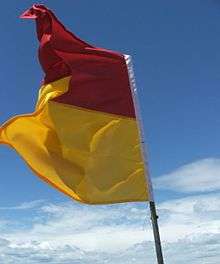Surf Life Saving New Zealand
|
SLSNZ Logo | |
| Abbreviation | SLSNZ |
|---|---|
| Motto | In it for Life |
| Formation | March 1, 1910 |
| Type | NGO |
| Legal status | Incorporated Society, Charity |
| Purpose | To protect our community in the water. |
| Headquarters | Wellington |
Region served | New Zealand |
Membership | 15 000 |
President | Neale Ames |
Main organ | Board of Directors |
Staff | 40 |
Volunteers | 15 000 |
| Website | SLSNZ Website |
Surf Life Saving New Zealand (SLSNZ) is the national association representing 73 Surf Life Saving clubs in New Zealand.[1] The organisation's motto is 'In it for Life'. This refers to both the long relationship many members have with the organisation, as well as to the organisations purpose of preventing drowning and injury, thereby saving lives.
Specific New Zealand beaches are patrolled by qualified Surf Lifeguards from mid October until April each year. Red and Yellow flags indicate that a beach is patrolled by Surf Lifeguards. The area of water in between these flags is designated as the safest place to swim on the beach, as well as showing where Surf Lifeguards are patrolling. It is widely publicised to "Swim Between the Flags" to be safe while swimming in the ocean.
Surf lifeguards are identifiable by their yellow shirts and red shorts. Surf Life Saving New Zealand is sponsored by BP, DHL & State Insurance.

History
In the early years of the 20th century, the New Zealand Amateur Swimming Association (NZASA) controlled the brief amounts of life saving activity by providing resuscitation methods and demonstrations at swimming club carnivals. The next step occurred when the Royal Life Saving Society (RLSS) was formed and enforced with a conference off all head centres in 1912 called by Canterbury. The RLSS was established in Christchurch and remains there to this day.[2]
The first surf clubs began in the years 1909-1910 leading of with: Castlecliff (Wanganui), Lyall Bay (Wellington), New Brighton (Christchurch) and Worser Bay Wellington. Within the next few years other clubs started forming around five regions: Wellington, Christchurch, Dunedin, Gisborne/Napier/New Plymouth and Wanganui.
In the Northern Region, Piha Surf Life Saving Club was founded in 1934, and as such is the oldest club on Auckland's West Coast and is the home of Piha Rescue.
Soon after the clubs were formed, rivalry began to take place which created the forming of competition between the clubs and regions. By early 1912 competitions were being organised by Wellington's Maranui Club, with male members competing in squads of 8. The competitions consisted of a land drill and 'reel test'. The first national champs where clubs were able to compete was held in 1922.
Surf Life Saving in New Zealand continues to grow in size and there are now 73 affiliated surf clubs.
Organisational structure
Surf Life Saving New Zealand (SLSNZ) is the national association representing 73 Surf Life Saving Clubs in New Zealand.
Around 15,000 people are members of SLSNZ. The 73 clubs are grouped for consultation and programme delivery purposes into local regions, and are supported by Surf Life Saving New Zealand staff. These new groupings were an outcome of the membership voting in a new and bold constitution in September 2009.
About surf lifesaving
In New Zealand, surf lifesaving is both a sport and a community service. To participate in either facet it is necessary to be a member of a club, and to have the ‘entry level’ qualification - the Surf Lifeguard Award, formerly the Bronze Medallion.
There are a range of other surf lifeguard and surf related qualifications available through the SLSNZ structure, including more advanced lifesaving certificates, Inflatable Rescue Boat (IRB) qualifications, VHF radio and first aid qualifications.
Volunteer lifeguards patrol beaches and work with the public to prevent people getting in trouble. In the summer of 2005 volunteers performed over 100,000 preventative actions during 155,000 hours of beach patrols.
Sport events are held at club, regional and national level, and in age categories Under 16, Under 19 and Open. Events span the range of rescue skills and test competitors’ strength, fitness and agility in swimming, running, paddling a surf ski, board or canoe or rowing a surf boat. Racing Inflatable Rescue Boats is an increasingly popular part of the sport.
Funding
SLSNZ's income is $6m a year derived from sponsorship, gaming machine grants and The NZ Lottery Grants Board. The organisation's total income is approximately $13m. SLSNZ does not charge a national membership levy, instead providing programmes and distributing over $2m each year to clubs.
Patrol statistics
For the 2011/2012 Season (last season), Surf Lifeguards attended the following incidents (as per annual report):[3]
Surf Life Saving New Zealand Totals
- Hours worked: 206,479
- Lives saved (rescues): 1,064
- First aid actions: 1,498
- Searches completed: 232
- Preventative actions: 84,280
- Safety interventions: 294,416
References
- ↑ SLSNZ Website: The Organisational Structure
- ↑ Jackson, Ivan (2006). Sand Between My Toes: the story of Surf Life Saving in New Zealand. Penguin Books. ISBN 0-14-302062-5.
- ↑ SLSNZ Website: Annual Reports

